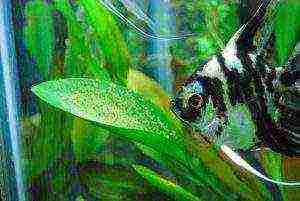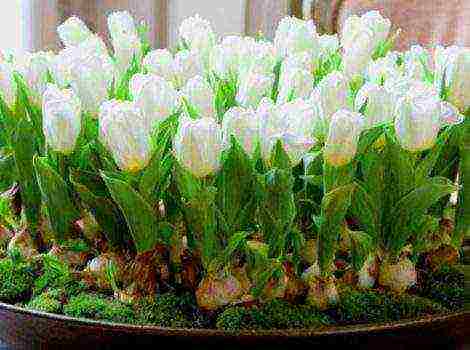Content
- 1 Description of the plant and the best species
- 2 Planting and caring for chlorophytum at home: optimal conditions for breeding
- 3 How to propagate chlorophytum at home?
- 4 Cultivation methods and soil preparation
- 5 How to care for chlorophytum?
- 6 Diseases and pests of the flower
- 7 Frequently Asked Answers
- 8 Mistakes of gardeners for growing chlorophytum
- 9 Description of the plant
- 10 Care instructions
- 11 Reviews and comments
In this article we will look at: growing chlorophytum at home from seeds. We will find out when to sow for seedlings and analyze the step-by-step instructions for planting and care.
Chlorophytum is not capricious, so there will be no problems with its cultivation. It grows quickly even in conditions that are not entirely favorable for it, but nevertheless, a beautiful and healthy plant can be obtained only with proper care. Consider how to care for chlorophytum. Read also the article: → "Plan for dealing with scale insects on indoor plants + the most effective ways"
Description of the plant and the best species
Chlorophytum is a herbaceous plant from the genus Liliaceae. For florists, there are varieties with narrow and wide leaves, as well as green and striped leaves.
Chlorophytum is a lush bush. The leaves are collected in a bunch and fit tightly to each other. As the leaves grow, they hang down and reach a length of 50 cm. Peduncles grow from the center of the bundle. Small white flowers. After flowering, young bushes with aerial roots are formed on the stems, which are used for reproduction.
Benefits of growing chlorophytum:
- unpretentious in care;
- growing rapidly;
- has a high decorative effect;
- can be grown hydroponically (no soil).
The plant blooms from March to October. A dormant period begins from October to January. Description of popular types in the table.
| View | Description |
| Crested | The leaves are long, hanging down, green with white longitudinal stripes. There are several varieties with a stripe in the center of the leaf and white stripes around the edges. |
| Curly | The leaves do not hang down, but curl. There is a wide white stripe in the center. The plant looks more compact. |
| Kapsky | Differs in its large size. Leaves are green without white stripes, up to 3 cm wide, peduncles on arrows are not formed. |
| Winged | Leaves are dark green, wide, up to 30 cm long. Grow on pink petioles. Peduncles with fruits similar to corn cobs. |
Cape chlorophytum reproduces only by dividing the bush.

Crested chlorophytum is the most common among florists.
Planting and caring for chlorophytum at home: optimal conditions for breeding
When growing chlorophytum, the conditions presented in the table must be observed.
| Parameter | Meaning |
| The soil | Loose, light soil. Rich in nutrients. |
| Soil acidity | Neutral reaction, pH = 6-6.5. |
| Illumination | Moderate, prefers shaded areas. |
| Air temperature | Not lower than 18 ˚С in winter. |
| Air humidity | Not less than 50%, in summer - not less than 70%. |
| Watering | In summer, abundant watering every other day, and in winter - moderate, make sure that the soil is not dry. |
| Spraying | Sprayed regularly from June to September. |
Chlorophytum loves light, but does not tolerate direct sunlight. It is also not worth growing a plant in the shade; it is better to put the pot on a windowsill on the east or west side. Read also the article: → "Cultivation of anthurium: features of the plant, its reproduction and the subtleties of care"

In the morning and evening, the plant can be left in direct sunlight.
Council number 1. Although the plant can withstand extreme temperature changes, do not leave it in a draft or near an open window. Decorativeness in this case will be significantly reduced.
How to propagate chlorophytum at home?
There are three ways to propagate a plant:
- Seeds. This is the hardest way. The percentage of seed germination of chlorophytum is only 25-40%. The day before sowing, the seeds are soaked in water. Sow in March on the surface of the soil, which consists of turf, peat and sand in a ratio of 2: 1: 1. The pot is covered with glass or foil, placed in a warm, shaded place with a temperature of 22-25 ˚С. The soil is regularly ventilated and moistened with a spray bottle. Seedlings appear in 1-1.5 months. Seedlings dive when 2-3 leaves appear, a week before the dive, the sprouts are hardened. The film is regularly lifted;
- By dividing the bush. Propagated by transplanting an adult (at least 3 years old) bush. The divided parts are planted in separate pots. The roots are divided with a knife, rotten or dry parts are removed;
- Lateral processes. This is a way of vegetative propagation. Shoots with roots are planted, which are formed on flowering shoots.

Children of chlorophytum, in which small roots are placed in water for several days, and then planted in the ground.
Cultivation methods and soil preparation
Adult plants are grown in pots and hanging pots, while seedlings are grown in peat tablets, hydrogels and in bottles. For planting in a pot, the soil mixture is prepared independently or they buy ready-made soil. Among the purchased brands of soils for decorative deciduous, the following can be distinguished:
- Ground Fields Russian "Biopergnoy". Contains all the necessary organic substances in an accessible form, as well as vermicompost, which increases survival and immunity. The soil is loose and permeable, the structure is ideal for chlorophytum;
- Soil for indoor flowers "Kekkila". Suitable for growing chlorophytum seedlings in large containers. The soil contains components that increase the effectiveness of fertilizing. The sand in the composition does not allow waterlogging of the soil;
- Bio-soil produced by Gera. Contains all the necessary trace elements, florgumate, dolomite flour, peat, sand and sapropel. The advantage of the soil is the presence of lake sapropel in the composition.
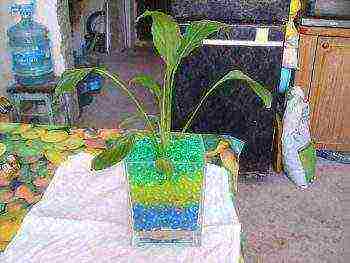
The action of the hydrogel is similar to sphagnum moss.
Prepare the soil on their own as follows: sod land, leaf humus and sand in a ratio of 2: 2: 1. Drainage must be placed on the bottom of the pot, expanded clay is suitable.
Chlorophytum is also grown in peat tablets. Before planting the seeds, the tablets are soaked in water. The seeds are pressed into the substrate with a wooden stick and covered with foil. Peat tablets, like hydrogel, are used only for growing seedlings from seeds.... The hydrogel can be used not in its pure form, but added to clay or heavy soil, because chlorophytum prefers a loose soil structure.
Some gardeners manage to grow chlorophytum in a bottle, but the plant needs a lot of capacity. A drainage layer is laid out on the bottom of the bottle, then the substrate mixed with charcoal is poured in a layer of 5-10 cm. The finished seedlings are placed in the soil with tweezers. This method is only suitable for vegetative propagation or growing plants from seedlings.

Coal prevents root rot.
How to care for chlorophytum?
Plant care is as follows:
- From the beginning of spring to autumn, the plant is watered abundantly up to three times a week, the soil should always remain moist;
- In the summer, the humidity of the air is increased by regular spraying of the plant;
- If the room is hot, it is advisable to put the flower on the balcony or take it out into the fresh air;
- The plant is fed every two weeks from March to August.Complex fertilizers are used for ornamental deciduous plants, they are sprayed on the leaf or poured under the root;
- Dry peduncles are removed, because they take away the strength from the plant and slow down its growth.
For the brightness of the leaves, you can use the foliar dressing "Bud"... Since the plant prefers nutritious soil, the decorativeness and color saturation of the leaves depend on fertilizers. Consider the brands of fertilizers for decorative deciduous plants in the table.
| Fertilizer | Description | Advantages |
| Etisso | Complex water-soluble mineral fertilizer. | Contains a full range of nutrients that are provided in an easy-to-consume form for plants, thereby instantly saturating with micronutrients. |
| Pokon "For all green-leaved ornamental plants" | Complex fertilizer in the form of sticks. There are 24 sticks in the box. | The complex of nutrients is specially selected for green-leafed plants. Easy to use, just press the stick into the ground. Does not burn the roots. Valid for up to 3 months. |
| Good power | Liquid fertilizer. Contains nitrogen, phosphorus, potassium and vitamins | Stimulates growth, development of the root system, improves decorative effect and nourishes the plant. |
| BonaForte | Liquid highly concentrated product | The composition contains succinic acid, which is a growth stimulant. Contains a high concentration of nitrogen, phosphorus, potassium and magnesium. |
| Fertilizer "Flower Happiness" | Liquid fertilizer for foliar application. | Gives juiciness and richness to the leaves. |
Transferring to a new pot
Plants that have not reached the age of three are transplanted annually. One plant is grown in one pot. It is advisable to transplant in February or March, before the active growth of the plant. Read also the article: → "Growing cacti: what you need to know about these unique plants?"
Council number 2. If you want the plant to bloom faster, then transplant it into a pot 10% larger than the previous one. In too large pots, flowering is delayed.
Transfer:
- Water the plant to make it easier to extract the root system;
- Prepare the soil for planting chlorophytum (the composition of the soil and fertilizers were mentioned above);
- Remove the roots along with the earthy clod and move them to the pot of potting soil;
- Sprinkle with soil on top and watered.
After transplanting, the pot is placed in a shaded place.
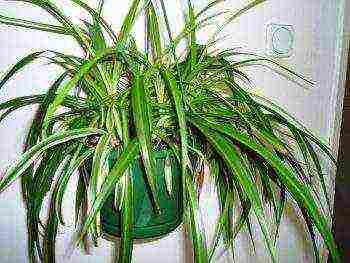
Large bushes are transplanted every 2-3 years.
Diseases and pests of the flower
With proper care, the plant is not damaged by pests. It is rarely affected by aphids, thrips, nematodes and mealybugs. For spraying, fungicides are used, for example, "Actellik", "Fitoverm", while always eliminating gaps in the care. For the prevention of diseases and pests, a fertilizer with a fungicidal effect called Sakhalin sodium humate for indoor and garden flowers is used.
When growing a flower, there are the following problems:
- The tips of the leaves turn brown and dry. Dry air or nutritional deficiencies;
- Leaves turn pale. The reason is non-observance of the temperature regime or insufficient lighting;
- The rosette of leaves is driven out by excessive watering or due to a heavy clay substrate;
- The leaves are too dark. The reason is the lack of lighting. On cloudy days in the evening they are supplemented with fluorescent lamps;
- Yellowing of the flower. The lower leaves turn yellow with regular waterlogging of the soil. In this case, the plant is transplanted into a new substrate. If the leaves gradually turn yellow, then the flower is cramped or lacking in nutrients.
To avoid flower diseases, monitor lighting, watering and indoor temperature.
Frequently Asked Answers
Question number 1... Why do leaf tips dry?
Answer: The plant dries out of dry soil or dry indoor air. Remember, in summer the humidity should be 70-80%.Such indicators are achieved by regular spraying of the leaves.
Question number 2... Should the plant be pruned?
Answer: No, chlorophytum does not need pruning. Only diseased and dry leaves are removed.
Question number 3... Is it true that chlorophytum purifies indoor air?
Answer: Indeed, chlorophytum is a natural filter that cleans the air from harmful impurities. Two adult plants in the room kill all pathogenic microflora. Chlorophytum also moisturizes the air if the flower is watered regularly.
Question number 4... How to check the acidity of the soil for growing chlorophytum?
Answer: There are folk methods and special devices for checking acidity. The latter includes a litmus test, which can be purchased at specialized stores. The color change is used to judge the acidity of the soil. Among folk remedies, vinegar is used. About 1 tsp is poured onto a handful of soil. vinegar. If there is a reaction (hiss and bubbles), then the soil is neutral, it contains a sufficient amount of lime. Similarly, grape juice is used instead of vinegar. The earth is dipped in a glass of juice, if there is foam on the surface, then the soil is neutral.
Question number 5... Is it possible to grow chlorophytum in a flower bed?
Answer: Yes. In summer, it is useful to transplant from a pot to a flower bed, but it is worth choosing a shaded area where the sun's rays appear only in the morning or in the evening. When the temperature drops below 15 ° C, chlorophytum is brought into the house.
Mistakes of gardeners for growing chlorophytum
Let's take a look at the common mistakes:
- When growing chlorophytum, it is necessary to select sufficient, but not too bright lighting. If you put the flower on the north side, then the lack of sunlight will lead to the loss of the decorative effect of the plant. On the south side, chlorophytum needs protection from the scorching sun;
- It is necessary to adhere to the correct irrigation regime, depending on the phases of the growing season. During the dormant period, watering is reduced, but during flowering, it is increased;
- If the plant does not bloom, then it should be transplanted into a larger pot. Young plants do not bloom either.
Rate the quality of the article. We want to be better for you:
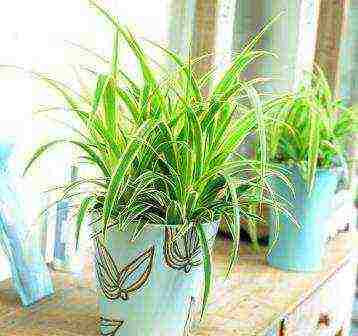 Chlorophytum is a popular houseplant. It can be found in many homes and offices. How to provide home care for chlorophytum? It grows rapidly and requires minimal costs. Suitable for beginner amateur flower growers. It is easy to care for it, it tolerates not the most favorable conditions in the room, it multiplies easily.
Chlorophytum is a popular houseplant. It can be found in many homes and offices. How to provide home care for chlorophytum? It grows rapidly and requires minimal costs. Suitable for beginner amateur flower growers. It is easy to care for it, it tolerates not the most favorable conditions in the room, it multiplies easily.
Description of the plant
This herb belongs to the lily family. It has long, hanging green leaves with a white or yellow stripe, which grow from a central rosette and reach 30 cm in length. Forms small white flowers with proper care in spring and summer. The main feature of chlorophytum is elongated shoots that form rosettes with aerial roots at the ends. The plant in this form resembles a spider, hence its popular name.
The homeland of the flower is South Africa. There are over 200 plant species found in the wild. Of these, only a few species are used as potted indoor flowers. These include:
- Chlorophytum crested. The most favorite kind of flower growers. The leaves are xiphoid, green with a central white stripe. After flowering, children are formed at the tips of the arrows, with the help of which it reproduces. Since many rosettes are formed at once, then, hanging down, they form a crest, which gave the name to the species.
- Chlorophytum Cape. Leaves are plain light green. Flowers are located on short shoots in the leaf axils. This species does not form rosettes, therefore plant reproduction is possible by dividing the bush.
- Chlorophytum orange. It is a species of winged chlorophytum, which is also called orchidostellar because of the wide lanceolate leaves growing on short fleshy petioles.As the name suggests, they have a deep orange color. On the lower part of the leaf blade there are protruding orange veins. Peduncles in this species are short and do not form children.
- Chlorophytum curly. It is very similar to Chlorophytum crested, but the striped leaves do not hang down, but wrap around a flower pot.
- Chlorophytum Laxum. Found in homes much less often. This species is dark green, striped around the edges. It reproduces not by children, but by dividing the bush.
Chlorophytum - unpretentious and useful (video)
The benefits of a flower
In addition to the decorative function, the plant has a number of useful properties, being a natural filter:
- absorbs carbon dioxide;
- cleans the air from harmful microorganisms;
- absorbs formaldehyde, phenols and other harmful chemical compounds.
It is recommended to keep the plant in the kitchen, where the greatest amount of harmful impurities accumulates. In the course of experiments, it was proved that the air within a radius of 2.5 m around chlorophytum becomes 80% cleaner. The peculiarity of the flower is that active growth is observed in the most polluted places. It is one of the best plants for improving indoor air quality. How to care for chlorophytum correctly and create the most favorable conditions for its growth and development?
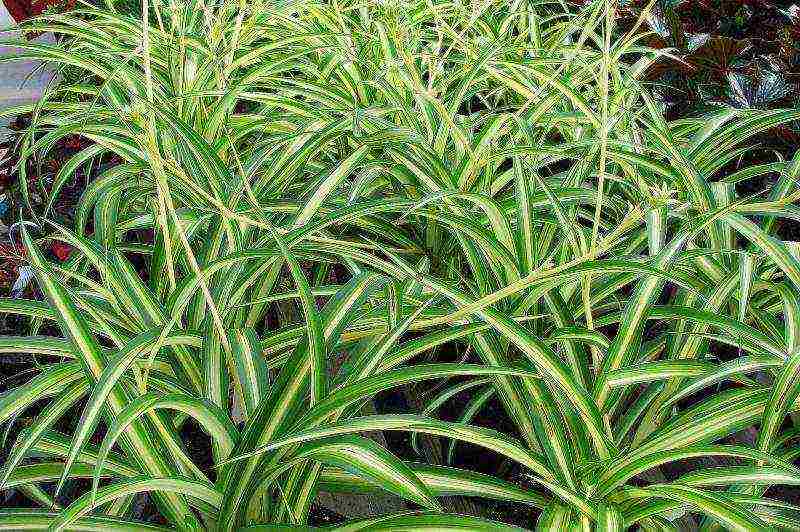
Care instructions
An important quality of the chlorophytum flower: minimal care is required. These plants look best in hanging baskets, pots or on pedestals, where they can show all the beauty of the foliage and nothing interferes with the growth of the stems. They go well with other cultures in flower arrangements.
How to properly care for chlorophytum? Some recommendations for watering, feeding and lighting should be followed. But even in adverse conditions, the plant survives due to the supply of nutrients in the rhizomes. Experiencing a lack of watering or lighting, the flower will lose its color brightness, stop growing, but once again in comfortable conditions, it will almost completely recover.
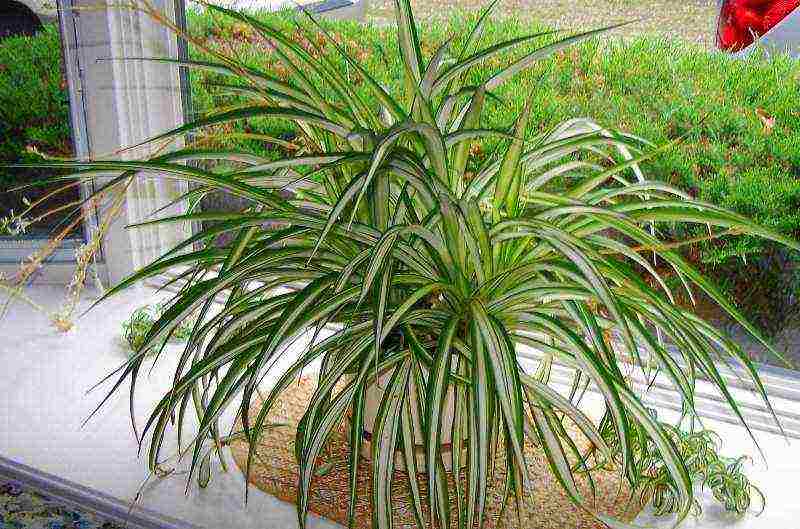
Temperature and light
Chlorophytum requires bright but diffused light. The windows located on the east and west sides are best suited. Direct sunlight should always be avoided as this can burn the foliage. Faint pale leaves indicate a lack of lighting. Varieties with variegated color show a solid color in the shade. In cloudy weather, fluorescent lighting is recommended. In summer, plant pots can be taken out into the fresh air.
The plant prefers moderately warm temperatures ranging from + 18 ... + 24 ° С throughout the year. Lower or higher levels of chlorophytum will tolerate, but will be damaged. In winter, the flower pot can be moved from the window into the interior of the room, which will protect the plant from cold air and drafts. It should be remembered that this is a representative of the tropical flora and the cold will not do him good.

Watering and humidity
The plant loves moisture, but does not tolerate stagnant water, so drainage is required. Intensive watering is required during the period of active growth and reproduction - from spring to autumn. Moistening is necessary when the surface of the soil becomes dry to the touch at a depth of 1-2 cm. This usually happens twice a week in the summer and once every 7-10 days in the cold season.
Chlorophytum is sensitive to fluoride in tap water. This leads to yellowing of the foliage. The water must be settled or distilled. Waterlogging causes root rot. If this happens, the flower should be transplanted into fresh soil, having previously removed all the rotten parts. The plant does not require additional spraying. However, if the indoor air is hot, dry, the leaves begin to dry out. In this case, you can occasionally pour over the flower from a warm shower.
Chlorophytum - growing and care (video)
Soil and nutrition
Chlorophytum soil should be loose and contain nutrients.Soils with a neutral or slightly acidic pH are considered optimal. The best is an earthen mix that includes 1 part turf, 3 parts leafy soil and 1 part sand. A drain is placed at the bottom of the pot so that excess water flows into the pan and air flows to the roots.
In the spring-summer period, the plant must be fed with fertilizers. Both organic and mineral mixtures are suitable, which can be alternated. The frequency of fertilization is usually 1 every 8-10 days. The flower does not tolerate excess sodium. You can feed it with a special preparation "Bud", which will give the leaves a rich color.
Chlorophytum is transplanted annually for a young plant. Adult specimens change the land no more often than once every 2-3 years. To transplant a plant, the shrub is removed from an old pot and transferred to fresh potting soil. The excess of the old substrate must be removed. If chlorophytum is not transplanted, it can stop growing and even die.
Improper plant care is the main reason why leaf tips dry out in chlorophytum. It can be:
- lack or excess of moisture;
- improper feeding;
- irregular transplant;
- lack of sun;
- dry indoor air.
It is necessary to find out and eliminate violations in the care, then the flower will delight with a juicy and bright crown.
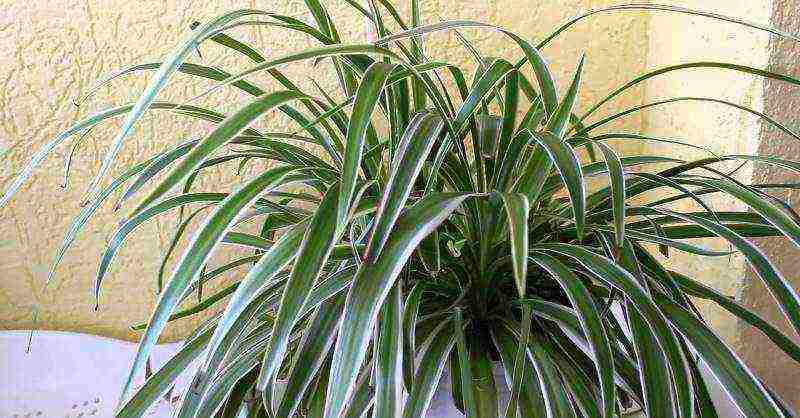
Reproduction
Reproduction of chlorophytum is possible in several ways:
- sockets;
- vegetatively (by dividing the bush);
- seeds.
The first method is the easiest for varieties that form babies. The rosettes must be separated from the main bush and placed in the water so that they give roots. After that, the sprouts should be transferred to a pot with a loose substrate. In this way, the flower can be propagated throughout the year.
Plant species that do not give a rosette can be propagated by dividing the mother bush, which is from 3 years old. The soil around the flower should be well moistened, carefully separate part of the bush without damaging the root system, and immediately placed in a separate container.

For chlorophytum, seed reproduction is extremely rare, since the germination rate is quite low. If, nevertheless, there is such a need, then it is better to carry out the procedure in the spring.
Attention, only TODAY!
Reviews and comments
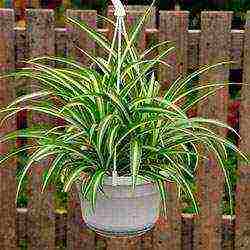 Chlorophytum is a houseplant that is great for beginner home growers. It is not whimsical to care and works as an indoor air purifier in a polluted urban atmosphere. Flower propagation is carried out by rosettes. You can even understand the technology from a photo. Moreover, chlorophytum takes root and grows quite quickly.
Chlorophytum is a houseplant that is great for beginner home growers. It is not whimsical to care and works as an indoor air purifier in a polluted urban atmosphere. Flower propagation is carried out by rosettes. You can even understand the technology from a photo. Moreover, chlorophytum takes root and grows quite quickly.
Description and characteristics of chlorophytum
If you have no time to do housework, but want to green up your apartment space, get chlorophytum. This perennial herbaceous shrub is characterized by long green leaves, sometimes with white stripes. Another feature is long dangling arrows with tufts of greenery at the end. Chlorophytum is not difficult to find in the market or in any flower shop.
The homeland of the indoor flower is Central America and South Africa. There, culture grows in river valleys. But, as it turned out, it will completely survive on the windowsill of an apartment with a careless owner. Chlorophytum is unpretentious and hardy. It grows in containers of any size, is not picky about the abundance of sunlight and temperature. The pot can be placed away from the window.

Chlorophytum is not a capricious and hardy plant
Even if you forget about watering for a month, chlorophytum will not dry out, although it will lose its tone. The powerful and fleshy root of the flower absorbs and stores moisture in case of an unexpected drought. If there is a lot of water, the bush will grow in depth and in breadth, and will also give abundant offspring. A well-groomed plant looks fresh and beautiful in different interiors. In addition, it functions as a cleaner for a vacuum cleaner. A pair of chlorophytums will cleanse the atmosphere of a 7 sq. m from:
- harmful radiation;
- burning;
- street dust
- harmful microorganisms.
Advice. If you decide to start chlorophytum in order to improve the atmosphere, florists are advised to purchase in addition to it a homemade cypress, which has disinfecting properties.
Chlorophytum types
This flower is usually hung in a planter or placed on multi-level flower stands to give free rein to the descending leaves. Many varieties are suitable for outdoor cultivation. Today in apartments you can find the following types of chlorophytum:
- Crested. The most popular. It has narrow long leaves and a mustache. Rosettes of miniature chlorophytums appear at the ends of these arrows. They can be rooted. The crested has several subspecies: with small white longitudinal stripes or one wide, slightly curly, curly leaves.
- Kapsky. It looks like a crested, but has wider leaves and does not form lateral shoots with offspring on the arrows.
- Winged. Gain popularity. Leaves are lanceolate, rather wide, on long petioles (in some varieties they are colored).
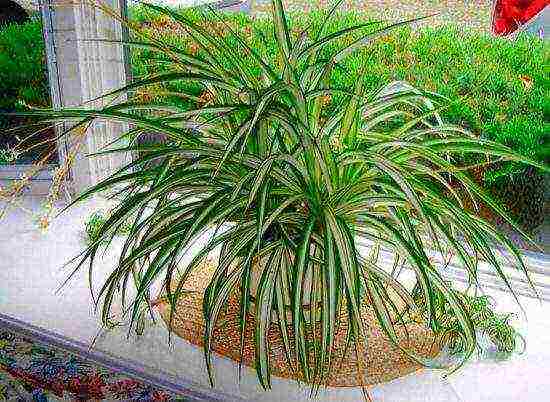
Chlorophytum crested
Reproduction of chlorophytum at home
There is nothing complicated in the procedure if you have an adult plant with a formed rosette on the arrow. This is the most popular way to reproduce a flower:
- you can disconnect the outlet at any time of the year;
- usually the lateral processes are able to take root on their own;
- for reliability, you can lower the torn outlet into the water for 1-2 days.
An alternative way is to separate part of the bush during transplantation. This technique of vegetative propagation is practically no different from the method with rosettes. Only a rooted plant will immediately become an adult. Chlorophytum is not propagated by seeds at home.
Advice. Use a substrate of leafy, turfy soil and sand when growing a flower.
Features of chlorophytum care at home
The plant will forgive the owner's inattention if there are at least minimal conditions:
- Chlorophytum can easily withstand temperature fluctuations. However, for normal development, still adhere to + 18 ° С, and in winter - at least + 10 ° С. The cold will not kill the flower, but dark spots may appear on its leaves.
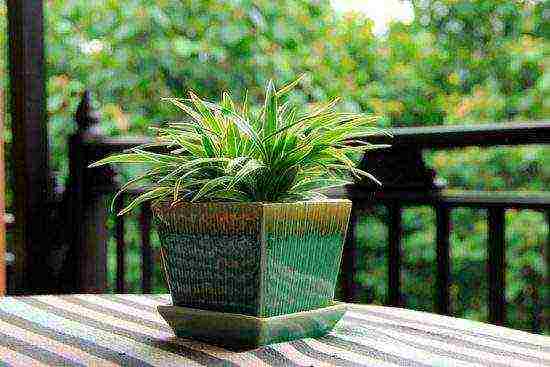
Protect chlorophytum from the cold
- It is best not to place the plant in a draft.
- Optimal lighting for chlorophytum is diffuse. Allowed 2-3 hours exposure to direct sunlight during the day. In the shade, chlorophytum will not fade, but in good light it will be more magnificent.
- In summer, the flower will feel best with abundant watering with settled water 2-3 times a week. The rest of the time, stick to minimal watering to keep the potting soil from drying out.
- In the summer, chlorophytum loves high humidity. It is achieved by spraying with standing water at room temperature. During the rest of the year, this procedure is not necessary.
- Indoor plant pruning is needed to get rid of damaged or dead parts. So they correct the shape of the bush.
- You can feed chlorophytum, but not more often than 2 times a month (from March to August). Use a mixture for ornamental deciduous crops.
- To maintain the beauty of the flower, from time to time wash its leaves with warm water to remove dust and dirt.
Attention! Improper care can result in dry leaf tips. Such areas need to be cut off, and the plant will regain its decorative appearance.
In the summer, you can place chlorophytum on a balcony, loggia or other place with fresh air. Also, make sure that the flower doesn't outgrow its pot. In this case, a transplant will be required.
Useful chlorophytum: video
Chlorophytum is a houseplant that is ideal for budding flower growers. He combines simplicity and beauty, while not being whimsical at all. Chlorophytum is one of the most common flowerpots today.It grows rapidly, and in spring and summer, small white flowers appear on thin stems, and then tiny rosettes of leaves. For details on how to care for a plant at home, read the article.
Content:
- Botanical description of the plant
- Chlorophytum care
- Reproduction of chlorophytum
- Possible growing difficulties
- The benefits of chlorophytums
Botanical description of the plant
Chlorophytum, Latin - Chlorophytum, folk - "spider plant", "spray of champagne", "family happiness", "friendly family".
Herbaceous plant with drooping stems. Its long, linear leaves are collected in basal bunches. The flowers of chlorophytum are small, collected in a loose panicle. Arcuate stems after flowering form bunches of leaves with aerial roots at their ends. Strong specimens have numerous hanging stems with rosettes of leaves.
In indoor floriculture, species with green and striped linear leaves are grown. They are collected in a basal rosette and arched to the sides, reaching a length of 40-50 cm. From the center of the rosette, long mustache-peduncles grow, decorated with small graceful white flowers, which later turn into small rosettes - children with air roots. Sometimes the flowers are pollinated and then the formation of a fruit is possible - a triangular capsule. There are about 250 species of this plant.
Chlorophytum care
Chlorophytum is a rather unpretentious plant, and it is not difficult to grow it even for beginners in indoor floriculture. It feels best in a light or slightly darkened place. It can be attributed to both sun-loving and shade-tolerant plants. But in the shade of variegated forms, the bright color of the leaves is lost. For several hours a day, it transfers direct sunlight.
It adapts well to a fairly wide range of temperatures. In summer, chlorophytum can be taken out into the open air, but it should be positioned so that the place where it stands is protected from wind and rain. In winter, it is advisable that the room temperature does not drop below 10 ° C.
Watering is abundant from spring to autumn, since it needs a lot of moisture during the growing season. With a lack of water, it forms numerous tuberous thickenings. In winter, watering is reduced, making sure that the substrate does not dry out between waterings.
Chlorophytum can tolerate dry air, but regular spraying has a positive effect on the plant.
Chlorophytum responds well to feeding, especially in spring. During the growing season, they are fed 2 times a month with mineral and organic fertilizers.
Chlorophytum is transplanted in the spring: in February - March, young annually, adult specimens in 2-3 years. The roots of chlorophytum grow strongly, so it is necessary to take wide dishes.
When transplanting, be sure to pay attention to the roots of the plant: if it has formed quite a lot of large tuber-like thickenings on the roots, this indicates irregular watering. The plant is transplanted into a substrate with soil acidity close to neutral (pH 6-7.5), light, loose. It is composed of sod, leafy, humus earth and sand (2: 2: 2: 1) or sod, leafy earth and sand (3: 2: 1). Good drainage is essential.
The plant is propagated, ideally in the spring, in practice - as needed, when the plant is too overgrown with peduncles or the roots have already filled the entire pot and there is almost no room left for the earth.
A strong "rosette" with a leaf length of about seven centimeters can simply be dug into a nearby pot with the ground, and the stem connecting it to the main plant, without cutting it, is pressed to the ground with a hairpin. When the shoot takes root, cut the stem.
Another option is to tear off the "baby", put it in a glass of water and wait until the roots are about 2-2.5 centimeters.(The main thing is not to forget to add water to the container - growing chlorophytums love to drink). After that, plant the scion in the pot in the usual way.
Chlorophytum tolerates division during transplantation. At the same time, overgrown roots can be cut by a third - this will not affect the state of the plant in any way.
Possible growing difficulties
The tips of the leaves turn brown (turn brown). The reason may be mechanical damage or lack of power, or too warm and dry air.
Brown spots appear on the leaves. Over-watering at high temperatures in winter may be the cause.
Leaves are limp and pale. The reason may be excess heat and lack of light, or lack of mineral nutrition.
The rosette of leaves began to rot. The reason may be that the soil is waterlogged due to too much watering, especially in winter, or because of a heavy substrate.
The leaves turn dark green and lose their variegated color. The reason is a lack of light, adjust it. On cloudy days, variegated forms need illumination with fluorescent lamps.
Lack of peduncles. The reason may be that the plant is in too tight a pot, or the plant is still very young.
Chlorophytums are rarely damaged by pests, but a very weakened plant can infect aphids, worms, spider mites.
The benefits of chlorophytums
Chlorophytum is considered an excellent indoor air purifier, including from various harmful microorganisms. Scientists have shown that a plant can destroy about 80% of pathogens and harmful fumes in the immediate vicinity of the plant in a day.
For example, formaldehyde vapors emitted by chipboards, plastics and other modern materials are neutralized by chlorophytum by 86%, carbon monoxide by 96%, and nitric oxide by 70 - 80%. One chlorophytum plant is able to neutralize toluene and benzene in room air. Thus, several chlorophytums are able to purify and almost completely heal the air in a medium-sized room.
The chlorophytum plant, which is very easy to care for, is truly a godsend for beginners in floriculture. Various colors and an abundance of species of this plant will help you choose a flower for every taste. And of course, do not forget about the cleansing properties of chlorophytum!

